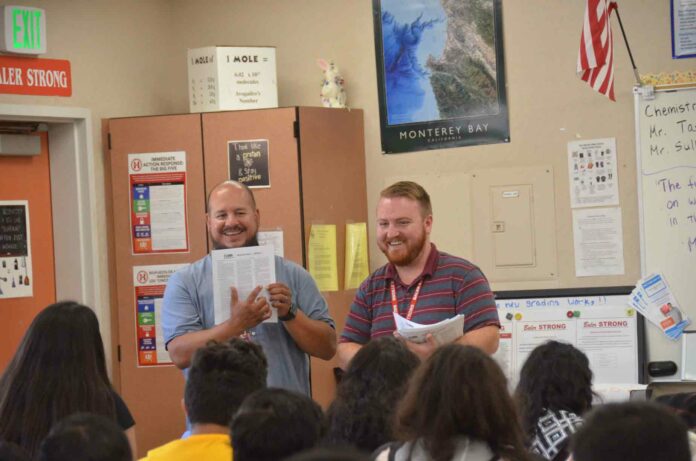Courtesy of San Benito High School:
San Benito High School District has inclusion as one of its pillars, with a goal of putting all students in the least restrictive learning environment in order to access the same quality education as their peers. At SBHS, one key component to successful inclusion for students with mild to moderate disabilities takes the form of co-taught options for a variety of classes. Co-teaching is a research-based model that emphasizes collaboration and communication among all members of a team to meet the needs of all students.
Co-taught classes at SBHS were piloted four years ago and range from ninth to 12th grade. By next school year, the roll out will be complete and span the educational spectrum, from Mathematics and English to History, Science, and Social Science.
“The classrooms keep pace with any other classrooms,” Special Education Director Dr. Paulette Cobb said, “and all students benefit from a reduced student-teacher ratio. This includes our advanced students, English Language Learners (ELL’s) as well as students with learning struggles.”
Most importantly, Dr. Cobb noted, co-teaching is a “research-based practice that assures students with mild to moderate disabilities are successfully educated in classes with peers who are non-disabled.”
Reaching Every Student
Molly Macierz, who co-teaches World Studies with Shae Walker and U.S. History with Derek Barnes, said the practice “makes the general education setting and curriculum accessible to all different types of learners.” Working alongside another teacher allows them to plan lessons “that are engaging and out of the box” and that reach every student.
“We are able to provide more feedback to the students because we are both grading and evaluating them,” Macierz said. “We are also able to talk to students more one-on-one because one of us is running the class while the other can be interacting with students individually or in groups. It’s kind of like we are two parents in the classroom and we are able to really care for each individual student’s needs.”
Individualized Attention
Joan Burley, who is in a co-taught math classroom with Tiffani Maria, said that when one of them is teaching to the whole class, the other can help individual or small groups of students who may be struggling with a concept.
“The student-to-teacher ratio is half of what it is in a class with one teacher,” Burley said, allowing for more individualized attention.
Regardless if a student is part of the special education or general education program, Burley said she and Maria “both feel like all of the students are our students” and they benefit as teachers by having each other to plan and grade.
“We have a lot of fun together and I think the students benefit from the atmosphere in the classroom that is a result of our great relationship,” Burley said. “Tiffani and I bring very different teaching experiences to the table, but we take those and use them to benefit our students.”
Filling in the Learning Gaps
Thomas Sullivan, who co-teaches Chemistry with Mason Taylor, said that having two teachers in a classroom who are experts in their respective fields is a “dynamic that allows for a more differentiated environment. Co-teachers are able to fill in the gaps and help in a deeper sense when it comes to guided discovery.”
In addition to additional, one-one-one support, Sullivan said students in co-taught classes “benefit from the different teaching styles and strategies” of their teachers.
Inclusion and Empathy
English co-teachers Amber Kearns and Irma Albright said that co-teaching is a benefit to all students, not just learners with special needs.

“I really enjoy co-teaching because we get to see the potential that so many students have,” Kearns said. “Students with extra learning needs realize they can be successful in a general education environment and gen-ed students learn about inclusion and empathy.”
She recalled the time one of her students on the spectrum gave a speech “with such enthusiasm and determination that they whole class erupted with pride and applause. Students were high-fiving him and we were beaming. Accomplishments like this happen all while keeping the same pace as the non-co-taught classes.”
Albright said that beyond the shared expertise and responsibility, students benefit from having teachers from “two different backgrounds that we can share with our students via anecdotal experiences. Mrs. Kearns was born and raised in Minnesota and I was born and raised in Hollister. I often refer to my Spanish language background when explaining an idea or experience.”

Since many of their students are bilingual, Albright said she can provide language reference clarifications about the day’s lessons while Kearns continues with a lesson.
The San Benito High School Strategic Plan, accessible on the school website at www.haybaler.org, outlines the district’s set of values and beliefs, such as inclusion including co-taught options, used to drive planning and decision making.
Photo caption for top image: Thomas Sullivan, left, and Mason Taylor co-teach at San Benito High School. Photo by Juan Robledo




